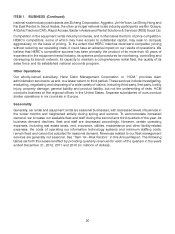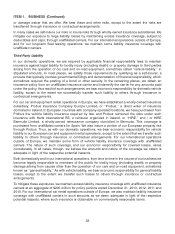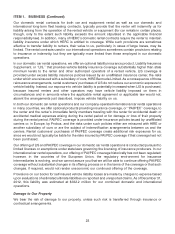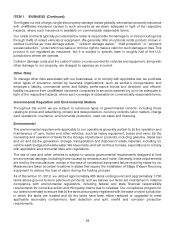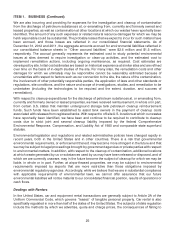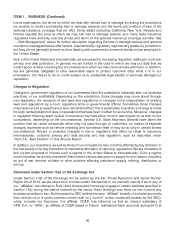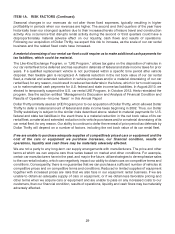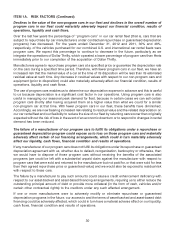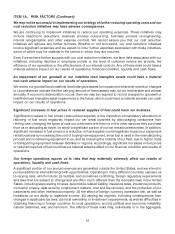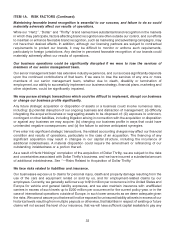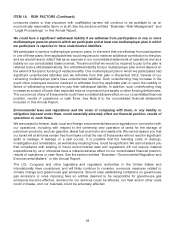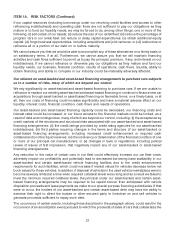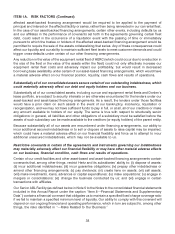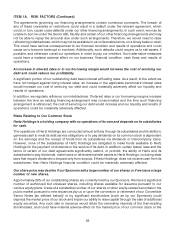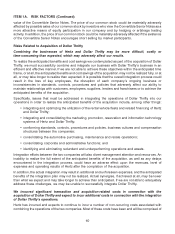Hertz 2012 Annual Report Download - page 54
Download and view the complete annual report
Please find page 54 of the 2012 Hertz annual report below. You can navigate through the pages in the report by either clicking on the pages listed below, or by using the keyword search tool below to find specific information within the annual report.ITEM 1A. RISK FACTORS (Continued)
Declines in the value of the non-program cars in our fleet and declines in the overall number of
program cars in our fleet could materially adversely impact our financial condition, results of
operations, liquidity and cash flows.
Over the last few years the percentage of ‘‘program cars’’ in our car rental fleet (that is, cars that are
subject to repurchase by car manufacturers under contractual repurchase or guaranteed depreciation
programs) has decreased. For the years ended December 31, 2012 and 2011, 30% and 48%,
respectively, of the vehicles purchased for our combined U.S. and international car rental fleets were
program cars. We expect this percentage to continue to decrease in the future, particularly as we
integrate the operations of Dollar Thrifty, which operated a lower percentage of program cars than Hertz
immediately prior to our completion of the acquisition of Dollar Thrifty.
Manufacturers agree to repurchase program cars at a specified price or guarantee the depreciation rate
on the cars during a specified time period. Therefore, with fewer program cars in our fleet, we have an
increased risk that the market value of a car at the time of its disposition will be less than its estimated
residual value at such time. Any decrease in residual values with respect to our non-program cars and
equipment (prior to disposition) could also materially adversely affect our financial condition, results of
operations, liquidity and cash flows.
The use of program cars enables us to determine our depreciation expense in advance and this is useful
to us because depreciation is a significant cost factor in our operations. Using program cars is also
useful in managing our seasonal peak demand for fleet, because in certain cases we can sell certain
program cars shortly after having acquired them at a higher value than what we could for a similar
non-program car at that time. With fewer program cars in our fleet, these benefits have diminished.
Accordingly, we are now bearing increased risk relating to residual value and the related depreciation on
our car rental fleet and our flexibility to reduce the size of our fleet by returning cars sooner than originally
expected without the risk of loss in the event of an economic downturn or to respond to changes in rental
demand has been reduced.
The failure of a manufacturer of our program cars to fulfill its obligations under a repurchase or
guaranteed depreciation program could expose us to loss on those program cars and materially
adversely affect certain of our financing arrangements, which could in turn materially adversely
affect our liquidity, cash flows, financial condition and results of operations.
If any manufacturer of our program cars does not fulfill its obligations under its repurchase or guaranteed
depreciation agreement with us, whether due to default, reorganization, bankruptcy or otherwise, then
we would have to dispose of those program cars without receiving the benefits of the associated
programs (we could be left with a substantial unpaid claim against the manufacturer with respect to
program cars that were sold and returned to the manufacturer but not paid for, or that were sold for less
than their agreed repurchase price or guaranteed value) and we would also be exposed to residual risk
with respect to these cars.
The failure by a manufacturer to pay such amounts could cause a credit enhancement deficiency with
respect to our asset-backed and asset-based financing arrangements, requiring us to either reduce the
outstanding principal amount of debt or provide more collateral (in the form of cash, vehicles and/or
certain other contractual rights) to the creditors under any such affected arrangement.
If one or more manufacturers were to adversely modify or eliminate repurchase or guaranteed
depreciation programs in the future, our access to and the terms of asset-backed and asset-based debt
financing could be adversely affected, which could in turn have a material adverse effect on our liquidity,
cash flows, financial condition and results of operations.
30


